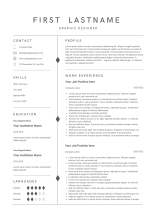
When you have completed your ABE studies, you're likely to be thinking about taking your career to the next level, but applying for jobs can become demoralising if you don't get invited for interviews. If this is happening to you read this blog of top tips to help you make sure your CV (or resume) will help you get that all-important interview.
Keep it short and snappy
When you’re applying for jobs it can be tempting to include every detail about yourself, but this may stop a busy employer from reading it properly. HR professionals recommend:
- No more than two pages for junior positions, no more than three for more senior.
- Short sentences and bullet points rather than long paragraphs.
- Plenty of white space, with clear sections, so it’s easy for the reader to pick out key details.
Work on a great personal statement or profile
This should be at the top of your CV. Think of it like your own elevator pitch, it's a way of quickly introducing yourself to your prospective employer, and summarising what personal qualities you can offer. It should be no more than three or four sentences highlighting the strengths and skills that are unique to you.
The format should be roughly who you are, what you can offer and what you're aiming for from your next role. It's very important to keep your aims aligned to the job on offer.
Show your experience
Start with your most recent employer and work backwards. Summarise what the company did, give a short description of your role (it’s fine to use bullet points) and highlight your achievements.
Don’t leave gaps in your CV but you can summarise less relevant information with a general heading and description.
Turn tasks into accomplishments
Where possible, rather than just listing duties, demonstrate what you learnt from them and how your work benefited the organisation, for example,
'Part of a market research team looking at customer preferences, administering and reporting on customer surveys'
Would be stronger if it was written as:
'Contributed to the organisation's understanding of customer preferences, by administering and reporting on customer survey data. This helped the company deliver a 5% improvement in customer retention.'
Be specific
If you did something on your own or led a project make sure this is clear. Don’t use general sentences that leave the reader with no idea what your involvement is comprised of. For your achievements, give specific examples such as how you helped to reduce costs, improve efficiency or increase revenue. But if not, quote an anecdotal example of something you have been praised for. Quoting an endorsement from a previous line manager with their name and title can be a strong way of making your CV stand out.
Don’t make one size fit all
If you are applying for a variety of positions in different industries you need different versions of your CV so you can highlight the strengths and experience most appropriate to the sector and role. If nothing else, tailor your personal statement according to the role.
Stress your qualifications
Employers value qualifications and you have worked hard to get them. ABE’s qualifications have many directly work-related learning outcomes so highlight those that match the skills required of the job you are applying for.
Make it look great
At the very least, your CV should be clear, neat and consistent.
Take a step back, and ask yourself does it look good? Do the things I need the employer to know, stand out?
If you search 'CV template' (or 'resume template') you can get some great inspiration of potential layouts. We've picked out some we like below but it's personal preference.
Check spelling and consistency
We all miss our own mistakes from time to time so use spell-check software or try techniques such as reading out loud to make sure there are no obvious grammar or spelling errors.
Also, take care with capital letters. Make sure they are consistently applied and if you capitalise a word in the middle of a sentence check whether this is correct and necessary. Similarly, check your full-stops. You can choose whether to end a bullet point statement with a full stop but make sure you apply your choice consistently.
Good luck.



Membership offer from The Institute of Leadership
Our parent company, The Institute of Leadership (IoL) is offering ABE graduates, from Level 5 upwards, the opportunity to become an Institute Member at a price exclusively for ABE qualification holders. Read more.
